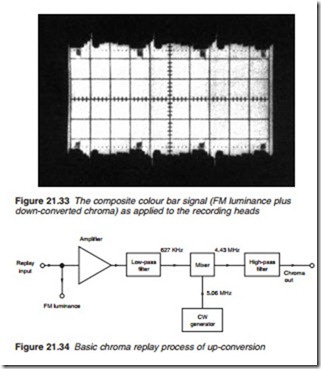Chroma recording
The down-converted colour-signal based (for standard VHS format) on 627 kHz, and containing amplitude and phase modulation, is recorded directly onto the tape. Its amplitude is carefully controlled to achieve max- imum modulation of the tape without non-linearity due to magnetic satu- ration. In this respect it is similar to audio tape recording, with the necessary HF bias being provided by the FM luminance record signal – the two are added in the recording amplifier, giving use to the waveform of Figure 21.32, where can be seen the recording-head signal for a colour-bar signal. The chrominance signal is superimposed on the constant-level FM luminance carrier, and this composite waveform is fed to the heads for recording on the tape.
During playback, the chrominance signal appears at the replay amplifier in the colour-under form described above and with a waveform like that in Figure 21.33. Impressed onto it are the timing variations, or jitter, intro- duced by the mechanical record and replay transport system and these have to be eliminated. First, though, the chroma signal is separated from the luminance FM signal in a low-pass filter, up-conversion to correct sub-carrier frequency (4.43 MHz) must also be carried out and we will take this first.
The 627 kHz is heterodyned with a local 5.06 MHz CW signal to pro- duce a beat frequency of 4.43 MHz, selected by a suitable bandpass filter. The idea is shown in Figure 21.34. DOC and crispening are not relevant to the relatively coarse and ‘woolly’ colour replay signal, and the recreated 4.43 MHz chroma signal is added to the luminance component and passed out of the machine.
